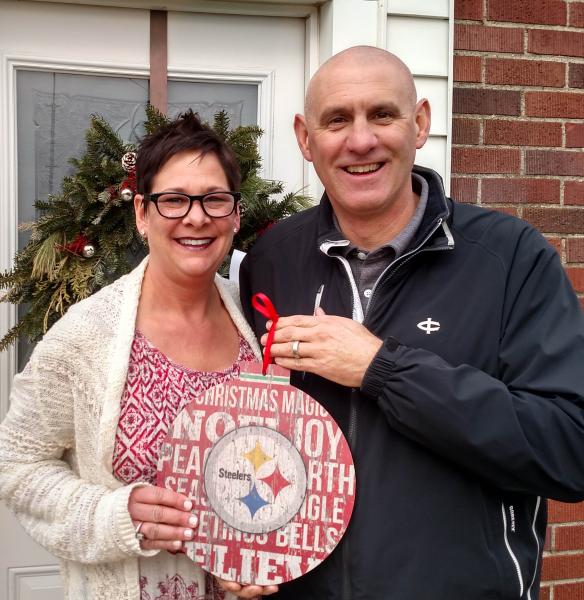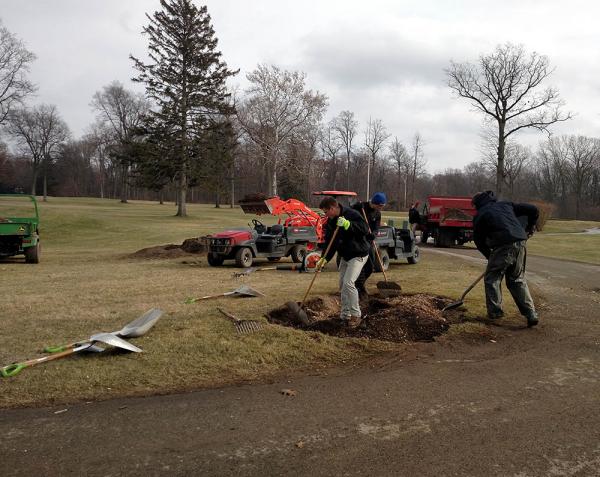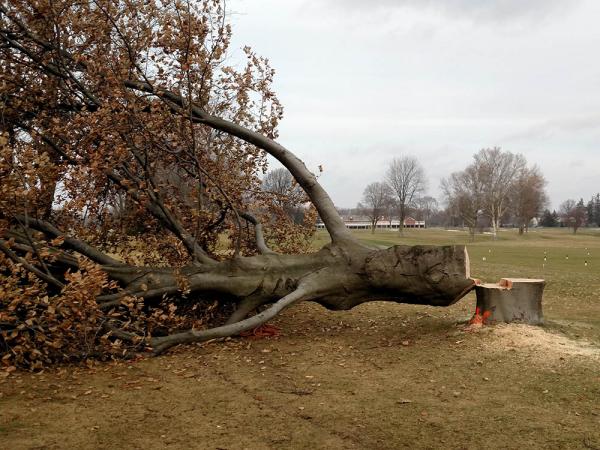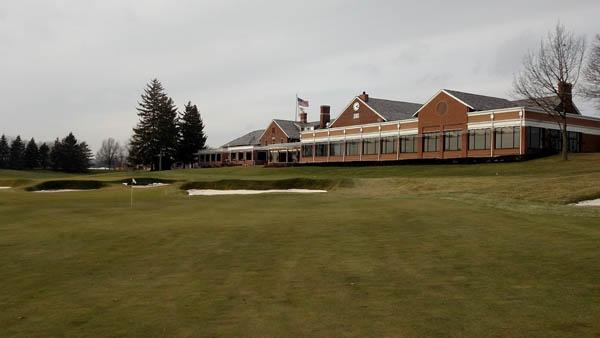Looming championships might make for a convenient excuse for a golf course restoration project. But truth be told, the famed Inverness Club in Toledo, Ohio might be going under the knife even without the beckoning call of the 2019 U.S. Junior Amateur and the Solheim Cup in 2021.
 Scores of mature trees and years of architectural updates and design changes had moved the course where Byron Nelson once was the club professional too far afield from what Donald Ross had envisioned when the club in southwestern Toledo hired him in 1916 to expand its original nine-hole layout to 18 holes.
Scores of mature trees and years of architectural updates and design changes had moved the course where Byron Nelson once was the club professional too far afield from what Donald Ross had envisioned when the club in southwestern Toledo hired him in 1916 to expand its original nine-hole layout to 18 holes.Questions like "What are we doing?" and "What do we want to be?" had become common around the clubhouse said John Zimmers, 48, who became the club's superintendent last April after 18 years of managing the world's fastest greens at Oakmont Country Club near Pittsburgh.
"Back in time" has been the overwhelming response to those questions.
"The history here at Inverness is unbelievable. The members have made a commitment to upgrade the facilities and the golf course and get it back close to what Ross had built," Zimmers said.
"This project is more for the members and everyday play. It's needed new bunkers for a long time and several holes no longer are part of the original design. The members wanted to take it back to the way it was in the early 1900s."
The club hired golf course architect Andrew Green to draft a master plan that included a restoration strategy of the course that Ross considered one of his favorites. Together with Zimmers, who rewrote the book on projects in nearly two decades at Oakmont, and McDonald & Sons, the Maryland-based golf course construction contractor that has moved more earth than Mount Vesuvius, Inverness has an all-star team in place to recapture the glory of Ross.
The project includes rebuilding all bunkers, some new contours, a few new tees and recapturing four holes that have been lost over time during previous restoration projects. The mounds, humps, bumps and valleys that Ross put in a century ago remain.
Although the new holes won't open until Zimmers says they are ready, most of the rebuild was completed through the golf season without a single hole being closed for play. Juggling the day-to-day management of the golf course and major projects is nothing new for Zimmers, who was seemingly always involved in large projects at historic Oakmont, where he prepped for the 2007 and 2016 U.S. Opens, 2010 U.S. Women's Open and the 2003 U.S. Amateur.
 There, he oversaw projects like the building of numerous bridges over and a wall alongside the highway during a Pennsylvania Turnpike construction project, the removal of thousands of trees, the Oakmont East Course project that transformed a cozy nine-hole layout into what essentially is a permanent staging area for the U.S. Golf Association. The course has been the site of nine U.S. Opens and three PGA Championships.
There, he oversaw projects like the building of numerous bridges over and a wall alongside the highway during a Pennsylvania Turnpike construction project, the removal of thousands of trees, the Oakmont East Course project that transformed a cozy nine-hole layout into what essentially is a permanent staging area for the U.S. Golf Association. The course has been the site of nine U.S. Opens and three PGA Championships.Those many projects include working hand in hand with city, county and state entities, railroads and federal agencies, including the Department of Homeland Security and FBI.
"Members here (at Inverness) ask how I'm able to do something like this and take care of the golf course, too," Zimmers said with a smile. "They don't realize, managing projects while taking care of the golf course is all I did.
"I've worked with Andrew and McDonald before, and between the three of us we have a lot of experience doing this. We lost some time because of the weather, so we didn't get finished. We'll get it done."
Changes to reclaim the glory days of Ross include reworking Nos. 2, 4, 5 and 8. The first is a replica of the second hold at Inverness that Ross built in 1916, while 4 is a recreation of the original No. 7, 5 is a replica of the original No. 13 and No. 8 is patterned after the original 6th hole, according to the Green.
Inverness has a storied past of its own. It has been home to four U.S. Opens (1920, 1931, 1957, 1979), two PGA Championships (1986, 1993), the 1973 U.S. Amateur and the U.S. Senior Open in 2003 and 2011.
Byron Nelson was the club pro there from 1940-44 and a grandfather clock in the clubhouse was a gift from Walter Hagen and other touring pros when the club became the first to let playing professionals into the clubhouse during the 1920 U.S. Open.
Green began working on the project with Zimmers' predecessor, Chad Mark, who left earlier in the year to accept the Muirfield Village job. The midstream change in superintendents was a concern for Green, until Mark's successor was named.
For those who think such a project might be just for the U.S. Junior Am or the Solheim Cup, the Master Plan includes new greens throughout the rest of the course as well, which won't be rebuilt until after the Solheim Cup in 2022, Green said. The project puts the course back on the map of great Ross designs.
There is such a deep sense of caring and ownership in the Inverness project from everybody. It's been so much fun and the end product is good because everyone is so invested in it."
"When Chad left to accept an amazing opportunity to work for Jack Nicklaus, I wasn't sure what would happen to the project, because it had already gained tremendous momentum," Green said. "When we found out they were able to bring John into the fold, you knew the project was in good hands with his experience and knowledge and what he brings to the table. He leads with a quiet confidence to make sure a project is the best it can be, and the membership got right in behind. It has been a great relationship and a lot of fun. It's been great to work with someone who had the vision and could see the end goal."
Zimmers and Green had worked together before, the first time for the 1995 U.S. Open when Zimmers worked for Paul R. Latshaw at Congressional just outside Washington, D.C. Green was a volunteer then and was on bunker raking duty. He also spent time working for McDonald & Sons, and any time a shovel was moved at Oakmont, it usually was McDonald & Sons that was moving it.
 "There is such a deep sense of caring and ownership in the Inverness project from everybody. It's been so much fun and the end product is good because everyone is so invested in it," Green said. "The membership has been fantastic. They all cared so much about what we were doing. Every time they came to play golf they found something new and exciting. They had a lot of patience for us working around them, and I think they appreciated us giving them space to play and enjoy the game. John always has done that at Oakmont, so he understands how that works, and McDonald, the majority of their work on renovations is done around play."
"There is such a deep sense of caring and ownership in the Inverness project from everybody. It's been so much fun and the end product is good because everyone is so invested in it," Green said. "The membership has been fantastic. They all cared so much about what we were doing. Every time they came to play golf they found something new and exciting. They had a lot of patience for us working around them, and I think they appreciated us giving them space to play and enjoy the game. John always has done that at Oakmont, so he understands how that works, and McDonald, the majority of their work on renovations is done around play."As Zimmers describes the changes that have been made at Inverness Club and those that have yet been made, there is an unmistakable spring in his step and a glimmer in his eye.
"I'm excited for the members," he said. "They are extremely proud of their club and they should be. I'm proud to be part of it."
For someone who has redefined the meaning of golf course renovations, Zimmers still has a passion for big projects, and he has a exudes a passion for Inverness and what is taking place there.
After 18 years on one of golf's grandest stages, Zimmers decided late last winter that it was time to try something new.
"Some people might say 'you stayed too long, you got burned out.' I never felt like that," Zimmers said.
What did begin to wear on him was the combined pressure of member expectations 365 days a year, managing the golf course and the constant wear of dealing with factors that had nothing to do with golf.
He left Henry Fownes only design in the capable hands of Dave Delsandro, a former assistant under Zimmers who returned to Oakmont a few years ago just to manage U.S. Open-related projects.
"These Opens are so big anymore. The 2016 open was something like 25 to 30 percent larger (in build out) than in 2007," Zimmers said.
"The Open is a monster. When you have to get 125 volunteers transportation, background checks, uniforms and whatever else, that is a job in itself. You're doing it at the end of the day and on weekends. You have to stay on top of it, or time gets away from you.
"I was not able to dedicate the time I needed to mentor and groom guys day to day who had come to work for me. I didn't have enough time, and that was unfair to them."

Then there was the human side. Zimmers says the pressure associated with 2007 Open had become so intense - there were wide swaths of dead or dying turf visible during a TV flyover that spring - that he temporarily lost sight in one eye. And exhaustion was a common theme for someone who worked 70-80 hours a week, not out of desire, but out of need.
"The things you have to deal with there, the turnpike, the railroads, those are not everyday things on the golf course that superintendents usually have to deal with," he said. "It can be overwhelming."
During Zimmers' years at Oakmont, his crews felled thousands of trees, transforming what had become a parkland-style course back to the wide-open look that Fownes created in the hills east of Pittsburgh in 1903.
He's started a tree-management program at Inverness, admittedly on a much smaller scale.
As members of his crew cut down trees and remove stumps on an unseasonably warm December day, plenty of trees marked with an orange "X" await the chainsaw. He admits to burning through seven or eight cans of orange spray paint and jokes that he should have an endorsement deal with Stihl. His crew has taken down about 70 trees so far, and although there is no hard number attached to the program, Zimmers believes the number could come in close to 200.
"The course will tell its own story," Zimmers said with a philosophical tone. "As we continue to change things, what it is supposed to look like will start to come out."
He's been a bit more philosophical since April. He and wife Tracey live in a remodeled home on the golf course, and today they get to do much more together than they did when was working those 70- to 80-hour weeks.
"Leaving Pittsburgh was hard. The Pirates, the Penguins, the Steelers, those are our sports teams. We have a lot of friends there. The biggest thing was leaving my staff. They're family," he said.
"I felt, after going through the last Open, with all the clean up and renovation, when this opportunity came along it felt like a good change of pace. This is a beautiful property with all the mounds and elevation, and it's a great membership that is very proud of their course.
"It was the right time."

